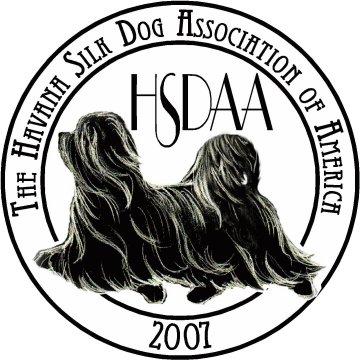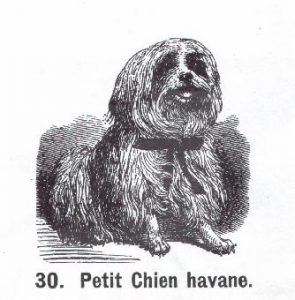|
If the Cavalier King Charles Spaniel enjoys the distinction of being the only purebred dog born of dissatisfaction, surely the Havana Silk Dog enjoys the distinction of being the only purebred dog born of an effort to eliminate a genetic problem from within a breed! The Havana Silk Dog, like the Cavalier King Charles Spaniel, is a “re-created breed.” It represents the efforts of a group of dedicated 21st century breeders to recreate a type of dog often referred to as the “Havana Silk Dog” which was popular in Europe in the 17th and 18th centuries (long before the organization of purebred dogs into formal registries) generally believed to have been developed in Colonial Cuba. Utilizing old paintings, sculptures, and written descriptions from the era as a guide, and by carefully selecting foundation bloodstock from the US, Eastern Europe, and Cuba displaying the phenotype sought, breeders have managed to produce a dog that both closely resembles these lovely dogs and which now “breeds true.” Through the efforts of a dedicated group of American Havanese breeders, who were determined to simply produce a more sound and healthy animal, the Havana Silk Dog reemerged, a breed of Cuban origin that was popular some one hundred fifty years earlier and long thought to be extinct. |
|
|
This disappearance, as it turns out, was apparently less a matter of true genetic extermination than a case of what cultural anthropologists term “extinction by assimilation”. As was true with the Cavalier and the English Toy Spaniel, the genes which had originally created the Havana Silk Dog were still alive and well, but had simply been assimilated into the modern Havanese breed over the years. Utilizing only rigid selection in an effort to breed away from dwarfism, this elegant little Cuban breed was restored to its original form, at first by accident and then by deliberate design, and was found to breed true within a very few generations. That the breed is very old is without doubt. As early as 1700, an entrepreneur by the name of Mr. Cowley brought a troop of small dogs advertised as “the Little Ball of Dancing Dogs” from Cuba to the court of Queen Anne, who was by all accounts enchanted by them and later owned several. Likewise the Toy Poodle counts among its earliest progenitors a breed of Caribbean origin known in England as the White Cuban, which translates neatly into “Blanquito Cubano”, an early name for the breed in its homeland. These so-called “small dogs of Havane”, or “Havana Silk Dogs”, were popular in the courts of Europe in the 18th, 19th, and early 20th centuries, and were exhibited in early shows there, but by the end of WWII, it appeared they had vanished from the Continent along with so much else, and were all but forgotten outside their Caribbean home. Then in the early 1970s, ads began appearing in American dog magazines for “Toy Havanese”, a purely American name given to the small dogs apparently brought to the US with Cuban immigrants in the decade following the Cuban Revolution. The descendents of these dogs formed the basis for the Havanese breed in America, and were exported throughout the 1980s to Western Europe in an effort to rebuild the breed there. In 2000, when it became apparent that the particular form of dwarfism often found in the Havanese throughout the US and Europe was associated with many of the health problems plaguing the breed, a small group of American breeders began choosing only those dogs with long, straight forelegs for breeding, adding straight-legged dogs from the Russian and post-revolutionary Cuban gene pools to strengthen their lines. Within three generations, a “new” dog started to emerge, and to reproduce itself with a consistency astonishing in a breed heretofore famous for its lack thereof. Besides displaying the straight legs and physical soundness that the breeders were selecting for, this “new” dog was invariably leaner of bone, with a much flatter, silkier coat, a longer, more refined muzzle and smaller ears, a longer neck, more angulation, a dropped croup, and a crosier tail carried waving like a plume high over the rump. In short, it was a much different, and much more elegant dog. In early 2007, those fanciers preferring both the look and general robust health of these very different dogs split off completely from the Havanese breed, establishing their own national Parent Club and registry for the express purpose of preventing any further interbreeding with the Havanese. The old name Havana Silk Dog was chosen for this newly restored breed because the traits displayed so consistently in these dogs (but not described in the current Havanese standard) were precisely those pictured and described in the dogs of Cuba prior to the establishment and subsequent popularity of the Havanese in the US. Because the restoration of the Havana Silk Dog was in truth a happy accident resulting from the founding breeders’ recognition of the importance of soundness and health in a breeding program, full registration of intact animals by the Havana Silk Dog Association of America, the breed’s national Parent Club, requires an OFA/CHIC number, a DNA profile, and a physical evaluation to exclude from the gene pool dogs displaying short or bowed forelegs and other deviations from soundness and traditional Cuban breed type. Copyright 2011 Havana Silk Dog Association of America |

